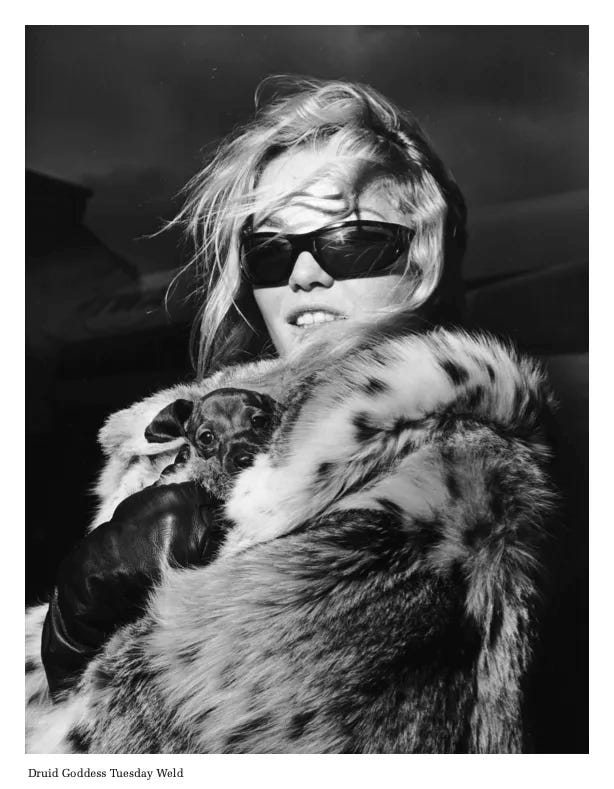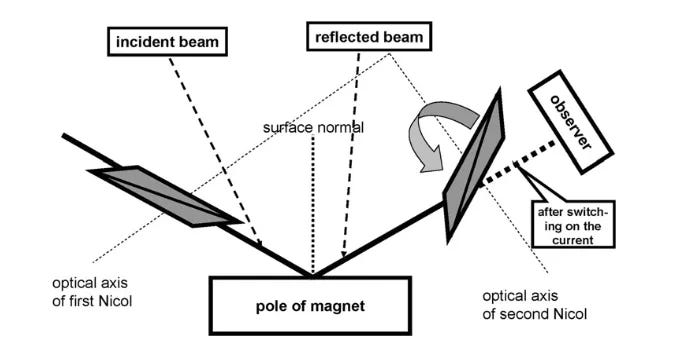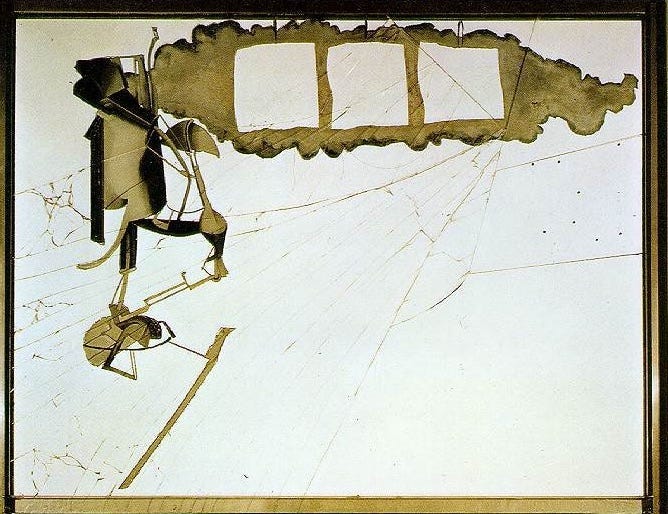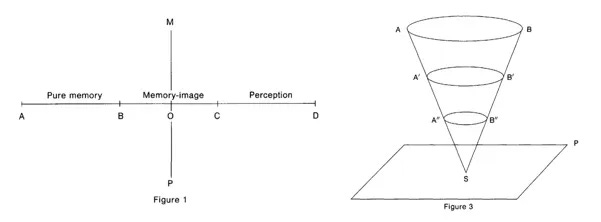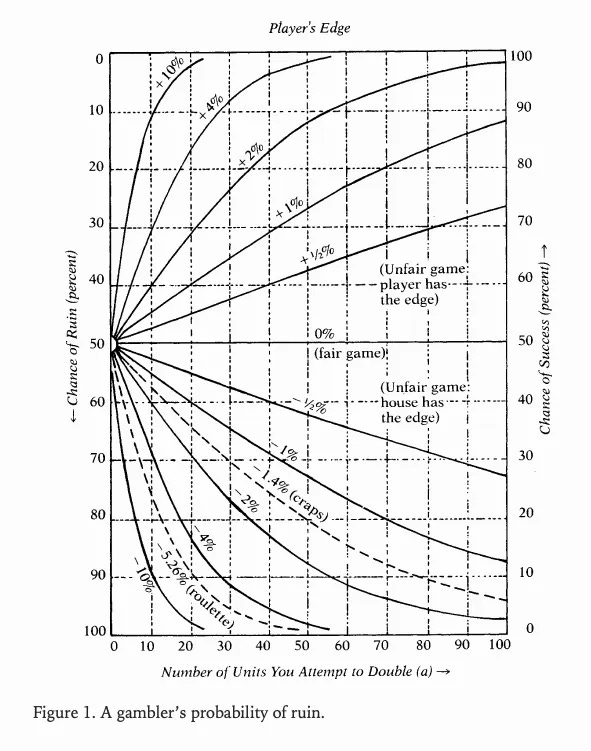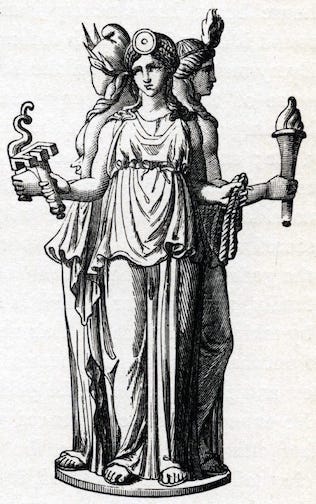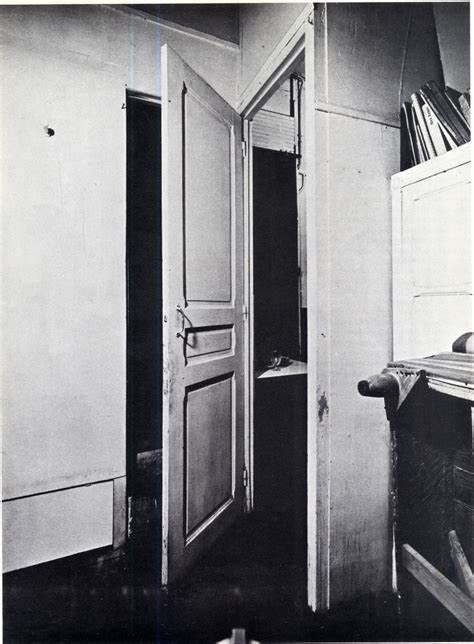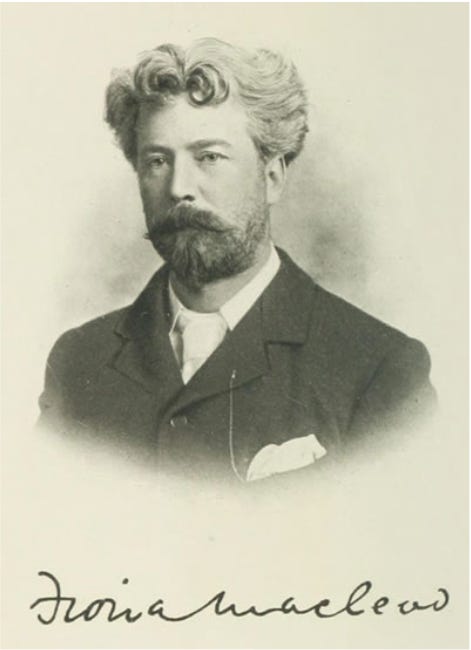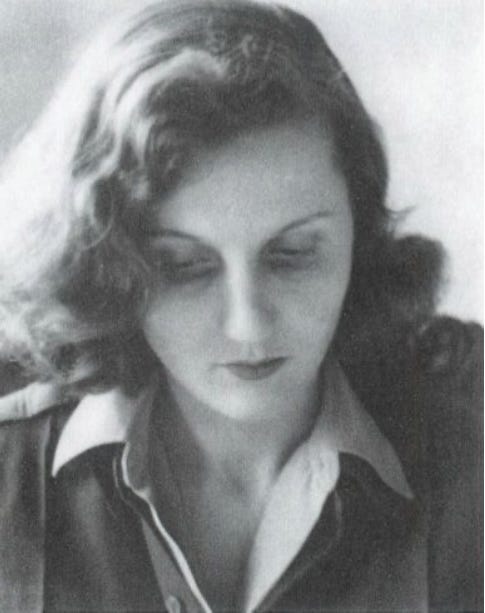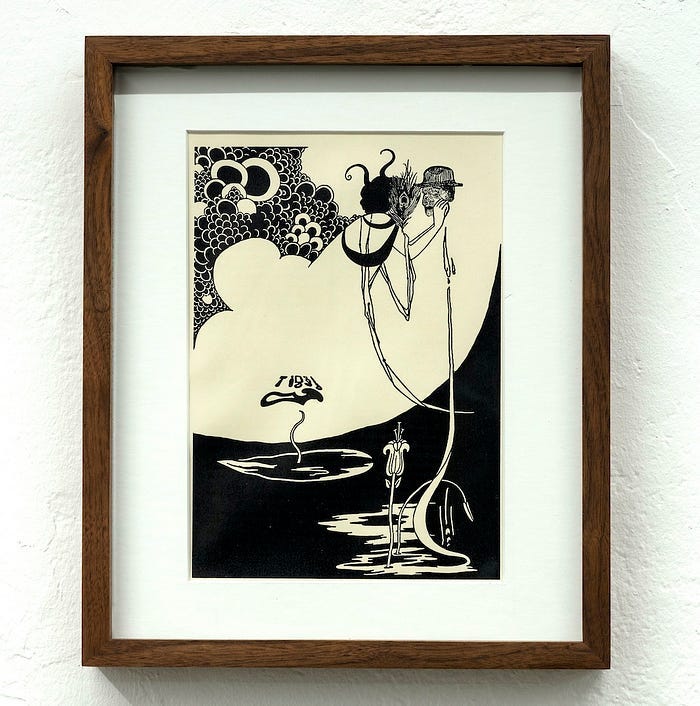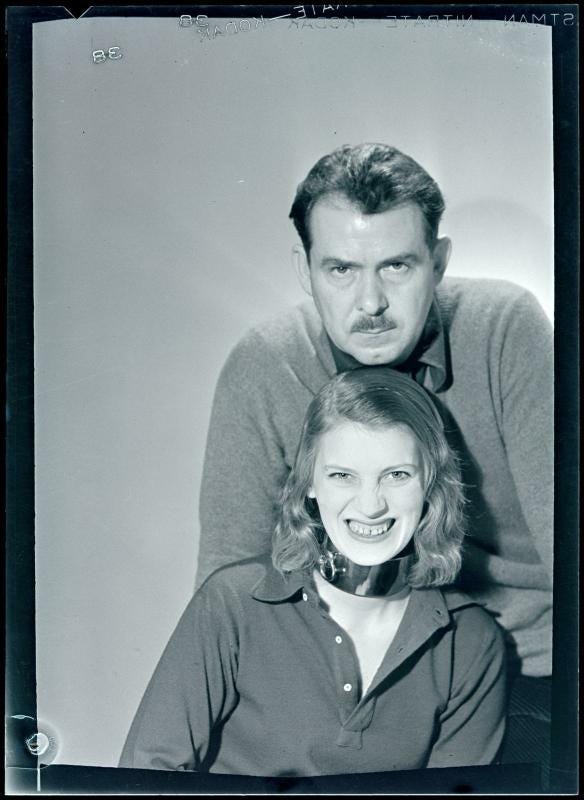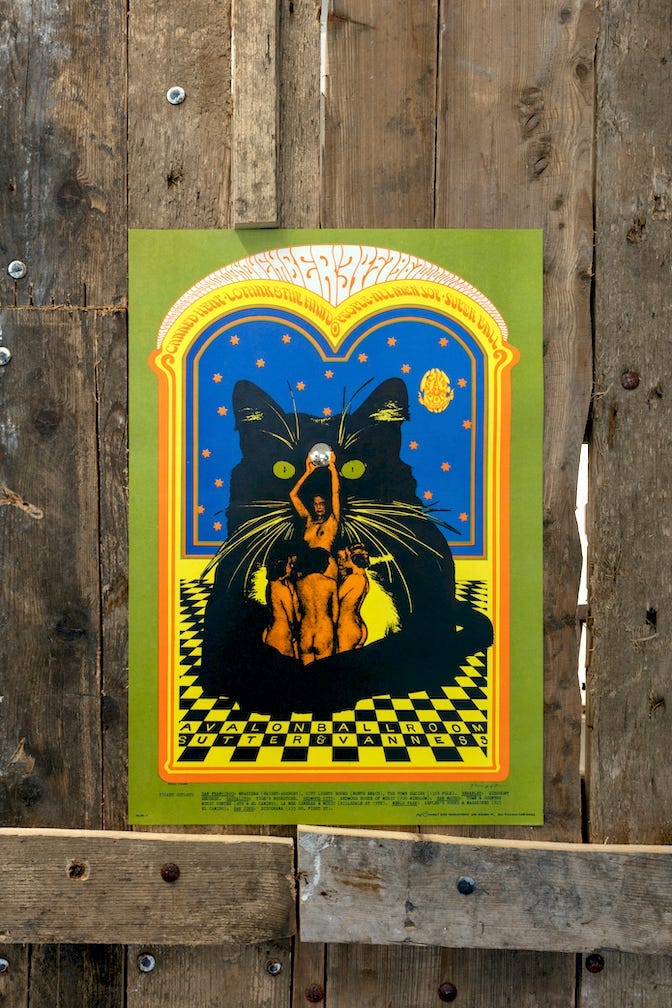Shadow casters work in the infra-thin
— notes on Vestigia
“No image can replace the intuition of duration, but many diverse images, borrowed from very different orders of things, may, by the convergence of their action, direct consciousness to the precise point where there is a certain intuition to be seized.” — Henri Bergson
“Druid Goddess Tuesday Weld” reads the description in the photo insert of Secret and Suppressed II (Feral House, 2008). Child-star-turned-Hollywood-star Weld, star of Lord Love a Duck, Pretty Poison, and Play it as it Lays, rumored lover of Elvis and Mick Jagger, confirmed lover of Al Pacino, Omar Sharif, and Mikhal Baryshnakov, long a focus of obsessional nuts and conspiracy theories, some of whom apparently believed her to be steeped in the Celtic Mysteries that W.B. Yeats had tried to codify a century earlier.
Weld is rumored to be the Ruby Tuesday of the Rolling Stones song and the “Tuesday” of the Beatles’ She Came in through the Bathroom Window (Sunday’s on the phone to Monday/Tuesday’s on the phone to me.) Her name, derived from a childhood nickname and adopted legally in 1959, acts in these songs as a coded signal to insiders– a “key”, an encipherment, and a lure. The assumed name (Susan Ker Weld/Tuesday Weld) is also a hinge…
Weld is descended from the Scottish Ker line. Her great-grandfather was the Scottish physicist John Kerr, discoverer of the Kerr effect: “…a change in the refractive index of a material in response to an applied electric field.” An electromagnetic field, when applied to a susceptible material, modulates its refraction of light. If material thus treated is placed between between polarizers, it goes dark. Kerr cells, used in photographic shutters, toggle near-instantaneously between light and dark.¹
“Shadow casters work in the infra-thin” Duchamp noted in The Green Box, referring to the figure — a higher-dimensional“imaginary entity” — dominating the top panel of The Large Glass. All shattered parts, imperceptible connective tissue, phantom limbs, The Pendu Femelle resembles a termite queen mated with a broken kite…
Esprit Jouffret, late 19th Century French artillery officer and mathematician — following the physicist Henri Poincaré — suggested the possibility of glimpsing a “section” of the fourth dimension from the third by way of its “shadow”. Duchamp notes that The Large Glass depicts: “a projection” in four dimensions in our world of three dimensions onto a surface of two dimensions.”
Inframince
In The Persistence of the Past, Henri Bergson diagrams the powerful influence of memory on our present perceptions and actions as they produce the future. In later elaborations of Bergson’s thought, philosophers Gilles Deleuze and Elizabeth Grosz suggest that varying intensities of differential forces carve through time and probability space, duelling with one another before settling on/producing the plane of the present, forming strata of human experience and (inhuman) materials — layers geological, genealogical, and otherwise. While motive action may respond to and enact something resembling desire or will, it is always overwhelmingly enchanneled by the near-imperceptible, iceberg-like force of the past. A tiny slice of action in the inframince — to use Duchamp’s term for minute difference in the fleeting present — correlates with the actualization of something like desire or will. This present-tense action can be directed toward what Futurists like James Dator and Stuart Candy have called “preferred futures.”
Art, with its complex, Lorenz-attractor-like vacillation between structure and freedom, order and chaos, is exemplary of the process of enacting what could be called “willful drift”, roughly analogous to “drifting” in films like Tokyo Drift (2006). A combination of physical forces–gravitation, velocity, viscosity, inertia, and resistance–are alternately amplified and suppressed through the physical dexterity and skill of the driver. Memory in the form of an “intuitive” understanding and exploitation of the effects of all of these forces produces the ‘drift’. “Muscle memory”, embedded in the driver’s body through repetition, harnesses physical, material, and gravitational forces, yoking them into an assemblage that vacillates between control and accident, luck and skill, invoking disaster at the outer limit and stasis at the inner.
Art bases whatever small claim it has on our attention on conceptual, formal, and structural differences resulting from the mobilization of that tiny margin of possible action and accumulation of opposed forces within the infrathin. Understood as a deployment of risk — defined by Dator and Candy as the mobilization of memory and physical action to enact directed movement — art winnows possibility space. Art, with its “willful drift”, invokes, summons, the risk of failure, of not landing the drift, or of landing it too quickly, being captured by stasis, failure, etc. ad infinitum.
Active risk differs from uninflected chance in its value asymmetry — never neutral, it is the exploitation of the possibilities of the infrathin present in an attempt to create an outcome that conforms to something like “vision” or “will”. It is the organizing factor of the “long shot,” the surprise, the unexpected outcome, the successful revolution, the difficult or impossible improvisation, the specialist medical or military operation.
Risk is actualized only in realtime, in the individual moment, on the invisible plane of the present P, which intersects the tip of the inverted prism of possibility in time, point S, in Bergson’s Figure 3.
Vestigia, traces of antecedent formations, make up the shifting ground of the present, P, that is continously altered and infrathin, comprising “the most minute of intervals, or the slightest of differences.”
The possible is an infra-thin. The possibility of several tubes of color (readymades) becoming a Seurat is the concrete ‘explanation’ of the possible as infra-thin. The possible implying the becoming–the passage from one to the other takes place in the infra-thin. — The Green Box
Tiny inflections in the infrathin make up the physical and mathematical structures that give player or house advantage in a game of chance. Per Thomas Bass in The Eudaemonic Pie (above), craps offers the player the least disadvantage, -1.4%, while roulette, the game that Thomas and his fellow Eudaemons “beat” using computers hidden in their shoes, sits at -5.4%.
Triads
The Triadex Muse–weird commercial folly of MIT’s Martin Minsky and Ed Fredkin, two of the “fathers” of AI ²–is a notably unmusical musical device that generates endless patterns of square-wave tones. It is also an early example of cellular-automata-driven generative AI. Its pyramidic form reflects the Triadex of its name, while “Muse” suggests creative forces from beyond the self and personal volition: the machine derives its evolving musical compositions and light patterns from uncannily complex digital phenomena that emerge from the simple rules governing cellular automata.
Ed Fredkin’s claims for cellular automata went far beyond musical composition: in Digital Mechanics, an early iteration of his “Digital Philosophy” (a ‘unified theory’ with cellular automata underlying all physical processes from galaxy formation to quantum mechanics), he writes:
DM is a Unified Discrete Field Theory of Physics wherein all particles, all their characteristics, all the numerical constants and all the laws of physics are emergent properties of the field. DM is totally defined by 8 constants….all quantities of DM, such as charge, spin, momentum, rest mass and energy are discrete. …One constant specifies the Rule of a Cellular Automata and the other the initial conditions. If DM is a correct theory then the 8 fundamental constants exactly define the past, present and future of the entire Universe, down to the most microscopic states and up to positions of all the stars
Mallarmé’s work-for-hire Les Dieux Antiques features an illustration of Hecate, a triadic muse. The triple-bodied Greek goddess of passageways, crossroads, and sorcery, Hecate was originally a chthonic deity that during the middle-Platonic era assumed a theurgic stellar aspect, acting as a bridge and transmission system for souls transitioning into the higher realms. According to Sarah Iles Johnston:
Hekate’s role as a goddess of crossroads actually is a single aspect of the broader role that she played from early times–that of guiding individuals through liminal points and during transitions of many types […] As a goddess who guided and guarded during transitions of all types, Hekate would have protected men against uncanny ghosts because ghosts were imagined to gather at liminal points. Naturally, she eventually became associated ever more closely with the ghosts themselves, for a mistress who could keep them at bay also could lead them on, and in her wrathful, unsupplicated moments give them free rein to wreak terror. It is a mistake, however, to emphasize this darker side of her nature to the exclusion of her protective characteristics.
Per Stephen Scully:
Johnston is the first to explain in a systematic fashion how this horrific goddess of uncanny things, goddess of cross-roads, patroness of witches, and ruler of the souls of the dead became among Platonic mystics the female principle of the universe, identified with the transcendent Cosmic Soul in whose womb “all is sown” and whose cosmological position is described as “between the two Fathers”. Her answer, simply put, is that in traditional and philosophical form Hekate is primarily associated with liminal points and boundaries […] in the Chaldean system Hekate was the middle element in a triadic order, thenurturing transmitter from Paternal Intellect to Second Intellect, from the realm of Ideas to the material world. She who stood formerly on the threshold between Hades and the upper world is now the “dividing bond” between the Intelligible and Sensible Worlds, structurer of the physical world, and source of individual souls. The magic associated with the traditional Hecate plays a similar role as a mediating art in the theurgical practices. In the spirit of their era, the Oracles seek to sanctify philosophy by allying it with religion.
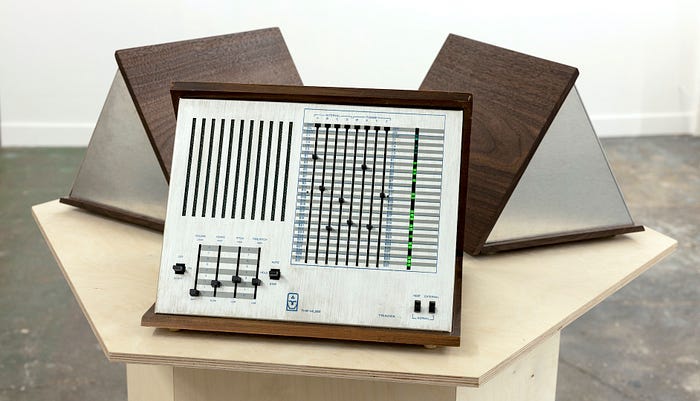
Every fake is also a hinge
Skilled seconds in hari kari left a hinge of flesh in place so that the head, mostly separated from the body, would sit in place, preserving the dignity of the practitioner. Half-truths trouble as they circulate. Quasi-epistemes hinge the possible to the actual by way of an ‘ironic causality’. Per Eric Alliez:
Door, 11, rue Larrey (1927), (was) ‘a single door which would close alternatively on two jamb-linings placed at right angles’ (Schwarz, 1970: 497). Since the door can be open without being closed, but never closed without being open as well, the hinge collapses around its pivot, which will soon be interrogated via an ‘ironic causality’ that hinges on the homonymy and homophony of the signifier unleashed by Duchamp’s ‘falconry (fauconnie`re)’
Pseudonyms, pseudopigographies, forgeries, fakes, all hinges collapsing around their pivots: assumed identities, acquired bodies, ex nihilo ontologies. Yeats’ ‘circle’s’ fauconnie`re: Henri Bergson’s sister Mina Bergson marries Yeats’ mentor S.L. Macgregor Mathers, becoming Moina Bergson Mathers. Each of these names a gambit, a hinge:
Samuel Liddell Mathers claimed to be the descendant of Ian MacGregor of Glenstrae, an eighteenth-century Scottish rebel, who fled his Highland home after the English defeat of the Jacobite rebellion in 1746 and found his way to France. […] …as Mathers’s Jacobite fantasies intensified, he paraded through the streets of Paris dressed in full Highland garb, with daggers protruding from his stockings (as Yeats noted, much “to the wonder of the neighbors”).
Each goes on to take another name, a “magical name”, given them by the Hermetic Order of the Golden Dawn: Samuel Liddel Mathers/S.L. Macgregor Mathers becomes Deo Duce Comite Ferro, Mina Bergson/Moina Mathers Macgregor becomes Vestigia nulla Restorum.
Opal Hush
For at least a decade, Yeats attempted to establish a “mystical Order” based on the Celtic Mysteries at Castle Rock. Per his autobiography, he wished to:
establish mysteries like those of Eleusis and Samothrace; and for ten years to come my most impassioned thought was a vain attempt to find philosophy and to create ritual for that Order […] (wherein) invisible gates would
open as they opened for Blake, for Swedenborg.
Per Marsha Keith Schuchard:
For a sexually tormented and jealous Yeats, the best way to harness Maud Gonne’s nationalist energies to the Kabbalistic power of Rosicrucian and Jacobite Freemasonry was to establish an independent “Castle of Heroes” on an island in Ireland. Yeats had “an unshakeable conviction” that “invisible gates would open,…as they opened for Swedenborg.” Mathers advised him on the symbolism and rituals, and Yeats worked on the plans for nearly a decade.
Fiona Macleod
Schuchard:
In the meantime, Yeats gained further access to the links between Scottish and Swedish Jacobite history, through his friendship with two descendants of the Scottish Macleods. The first was a fantasy figure, Fiona Macleod, created by the split personality of William Sharp, a talented and prolific Scottish author. The other was the real personality of the Countess of Cromartie, a genuine descendant of the eighteenth-century Jacobite Lord Macleod, who became Count Cromartie in the Swedish nobility and initiate of the Swedish Rite of Masonry.
William Sharp was of mixed Swedish-Scottish ancestry…He eventually became so obsessed with Celtic fantasies that he developed an alternate personality, Fiona Macleod, who provided him with a Jacobite ancestor and personality, even more bizarre than Mathers’s Comte de Glenstrae. Sharp was familiar with the role of the eighteenth-century Macleods in the Jacobite rebellion of 1745 and of the Macleods’ long ties with Sweden. In her spirit-dictations, the fantasy Fiona hinted to Sharp that he descended from or reincarnated her Jacobite father, which provoked Yeats and Mathers to pester Sharp for detailed descriptions of the Highland garb and Macleod-Mackenzie tartan worn by Fiona’s father…Yeats believed that Fiona was a Swedenborgian “astral body” and he later praised Sharp-Macleod as a man “through whom the fluidic world seemed to flow.” In the 1890s, he worked with Sharp to develop a special “Masonic Rite,” which received inspiration from a vision experienced by “Fiona.”
…Yeats eventually realized that Fiona was a psychic projection and not an actual Macleod…
Like the Pendu Femmelle, “Fiona Macleod” is projected onto the page by way of her “channel” William Sharp and the hand of his sister Mary Sharp.
Raccoona
From The New York Times:
In 1921 in the Belgian Congo, a six-year-old girl from Chicago with a pith helmet on her blond curls walks at the head of a line of heavily laden native porters. Her mother walks next to her, holding a rifle and her daughter’s hand.
In 1929, the girl huddles under quilts in a cabin in the Great North Woods, reading Weird Tales. The candle by her bed flickers as an alien gently removes a young human’s brassiere.
On Christmas Eve 1934, a nineteen-year-old in a white beaded evening gown makes her debut. At the party she meets a handsome, dark-haired boy in a tie and tails. She makes a joke; he laughs, and makes another. Five days later they elope and marry.
In 1942, a divorcée wearing three-inch heels and a fox fur jacket goes down to a Chicago recruiting station and enlists in the army.
Sometime in the near future, a woman and a man meet an extraterrestrial exploring party. The man tries to protect the woman. The woman says she doesn’t believe in women’s chances on Earth, and asks the aliens to take her away.
In 1970, a man who does not exist sits down at a typewriter. He writes, “At last I have what every child wants, a real secret life. Not an official secret, not a Q- clearance polygraph-enforced bite-the-capsule-when-they-get-you secret, nobody else’s damn secret but MINE.”
Alice B. Sheldon, child explorer, artist, debutante, CIA agent, award-winning, pseudonomous, gender-swapping science-fiction author ( James Tiptree, Jr.) , species-swapping science-fiction zine artist and writer (Raccoona Sheldon), rumored author of the MJ12 and Project Serpo UFO disinformation operation/hoax.
Names and identities multiply: Samuel Liddell Mathers/S.L. Macgregor Mathers/Deo Duce Comite Ferro, Mina Bergson/Moina Bergson Macgregor Mathers/Vestigia nulla Restorum, William Sharp/Mary Sharp/Fiona McLeod, Alice B. Sheldon/ Raccoona Sheldon / James Tiptree Jr., Marcel Duchamp/Rrose Selavy, Susan Ker Weld/Tuesday Weld/Tuesday. Identity is another infra-thin, every assumed name a shadow and a hinge³ leading inevitably to:
Hodos Chameleontos, Mirror Hearts
The Path of the Chameleon, per Yeats, is: “a condition of imaginative paralysis caused by venturing too far, too deeply, into the domain of symbols” and “overly seductive truths that overwhelm the mind’s capacity to assimilate them.”
Yeats, in his Autobiography, expanded upon his fruitless pursuit of the Celtic Mysteries:
…I prayed to the Red Rose, to Intellectual Beauty: Come near, come near, come near–ah, leave me still
A little space for the Rose-breath to fill,
Lest I no more hear common things . . .
But seek alone to hear the strange things said
By God to the bright hearts of those long dead,
And learn to chaunt a tongue men do not know.I do not remember what I meant by “the bright hearts,” but a little later I wrote of Spirits “with mirrors in their hearts.”
My rituals were not to be made deliberately, like a poem, but all got by that
method Mathers had explained to me, and with this hope I plunged without a clue into a labyrinth of images, into that labyrinth that we are warned against in those Oracles which antiquity has attributed to Zoroaster, but modern scholarship to some Alexandrian poet. “Stoop not down to the darkly splendid world wherein lieth continually a faithless depth and Hades wrapped in cloud, delighting in unintelligible images.”
Gematria, Notarikon, Themura
Per historian of hacking Scott J. Shapiro, code can be divided into three registers: upcode, downcode, and metacode. Downcode is technical computer code, invented languages designed to run machines–from the microcode embedded in microchips, to individual OS’s, to the code that runs the internet. Upcode is the mesh of forces–structural, social, cultural, biological–that structure human subjectivities. Metacode is the physical, material infrastructure that allows for the formation of downcode. Shapiro:
If downcode is what’s literally below our fingertips, the instruction we tap out, upcode, is what’s going on above those fingertips — from the inner operations of the human brain to the outer social, political, and institutional forces that define the world around us. Upcode includes the mental codes that shape human thought and behavior from within and the cultural codes that operate on us, often invisibly, from without: personal morality, religious rituals, social norms, legal rules, corporate policies, professional ethics, website terms of service. Downcode is run by computers, upcode by humans. […] Upcode is key to understanding hacking for a simple reason: upcode shapes downcode.[…] Metacode…is the code for code — the code that must “run” before computer instructions can execute.
[…]
Alan Turing was only twenty-four years old in 1936 when he published his seminal article, “On Computable Numbers,” in which he set out the principles of metacode. Turing showed, for example, that computation is a physical process. When your calculator adds 2 + 2, when Amazon.com searches its database for a book, when the telephone company routes your call, or even when your visual cortex processes these words, physical mechanisms are working: switching circuits, sending pulses of light, forming neurochemical reactions, and more.
Metacode–the material infrastructure necessary to downcode–acts, like Thumura, as a hinge, interfacing the material and social with the immaterial, the representational, the virtual.
The code undergirding Yeats’ and Moina Mathers’ work: Gematria–hidden correspondences between names and words revealed by numerical relations, Notarikon–the compression of truths into Hebrew letters, Themura–a hinge, allowing for translation, adaptation.
Collector and patron of 20th Century Modern art Walter Arensberg authored numerous books on cryptography, including The Cryptography of Shakespeare, The Cryptography of Dante, and The Secret Grave of Francis Bacon at Lichfield, and contributed ciphers to Duchamp’s artworks With Hidden Noise, 1916 and Comb, 1916. Within Duchamp we could say With Hidden Noise, Comb = downcode, Nude descending a staircase, upcode, The Readymade, metacode.
Vaporware: ‘Vestigia Nulla Retrorsum’ (‘No Traces Behind’)
Conceptual art has not however, as yet, broken down the real barriers between the art context and those external disciplines — social, scientific, academic — from which it draws sustenance…interactions between mathematics and art, philosophy and art, literature and art, are still at a very primitive level. – Lucy Lippard, Six Years: The Dematerialization of the Art Object from 1966 to 1972…1973
Continuing Lippard’s disappontment, Vestigia Nulla Retrorsum, 2023, is vaporware. A speculative economic/electronic/cultural assemblage. Vaporware troubles the distance between the symbolic and the real by introducing complex oscillations between virtual and actual:
Vaporware is a term commonly used to describe software and hardware that is announced, sometimes marketed, but is never actually produced.
Whilst an element of unfulfilled promise exists for all vaporware, the intentionality behind its production can be varied…vaporware is sometimes used by companies to drive up their share prices, to create extra publicity for their brand, or even deter competitors entering a market. In most cases new products become vaporware due to difficulties during development that result in these products falling behind schedule and/or being surpassed by competitor products in the market. It is typical for the companies producing vaporware to promise more than their developers can possibly achieve in the given time frame.
Vaporware functions memetically within the structural logic of capital (including “cultural capital”) as shortcode–operating on the upcode and (sometimes) the metacode while leaving out the downcode. Often its “spin off” effects are actualized through other channels.
Moina Bergson Mathers “magical name” Vestigia Nulla Retrorsum symbolically counters one of the core ideas of her brother Henri Bergson’s contributions to philosophy: in Bergson’s work memory and traces of the past have real effects on the present and thus the future. Moina’s motto Vestigia Nulla Retrorsum militates in the opposite direction: not a trace remains.
The assemblage Vestigia Nulla Retrorsum traces the increasing power, virulence, and near-invisible virtuality of hyperfinancialization, especially of doppleganger “virtual economies” (crypto, game economies, “scamworlds”, et al.), mining this near-invisible spectrum for symbolic transactions that sometimes translate into real effects. Per Jean-Joseph Goux:
Gold [Marx writes] , in so far as it performs the function of coin or in so far as it continually circulates, actually forms only a connecting link between the metamorphoses of commodities. What functions in the symbolic representation is not materialized value but only connection, linkage, relation. The symbolic order of currency is that of pure concatenation . . . in that the circulation process in the world of commodities takes shape as “a link not only of one endless chain metamorphoses, but of many such chains.”
The Vestigia Nulla Retrorsum terminal tracks movement within dark pools, the little-known but increasingly massive shadow realm of opaque financial markets existing outside public view. In Diving into Dark Pools, Sabrina Buti, Barbara Rindi, and Ingrid M. Werner write:
….there is a growing demand for trading venues that make it possible for institutions to keep their orders secret, offer low commission rates, maximize the chances of trading with other institutions (as naturals), and allow institutions to trade in size at the mid-quote. Such non-displayed pools of liquidity have been present in US equity markets for a very long time.
Nowadays opaque sources of liquidity are often grouped together under a single label (with unfortunate nefarious connotations): dark pools. In broad brush terms, dark pools are characterized by limited or no pre-trade transparency, anonymity, and derivative (almost exclusively mid-quote) pricing.
The “index/instrument” tracked by the Vestigia Nulla Retrorsum terminal is Gyre (from Yeats’s “widening gyre”). The vestigial gyre (in contemporary parlance, the churn) animating the dark pools can be visualized as a cloud t-SNE of data or–in the case of Gyre (Typhon), 2023–as a fluid dynamics simulation, with movements resembling those of typhoons (Typhons) or the spiral arms of galaxies. Goux continues: In this world of circulation, monetary forms are fleetingly articulated, strung together, but not arrested in the form of use-value. . . . Extended circulation thus makes viable. . . a purely symbolic order…
The oscillations in the epistemic/ontological gyre introduced by Vaporware leads to the creation of Vaporworlds.
Paul Coulton and Joseph Lindley from Game vaporware as design fictions:
…when General Motors sponsored designer Norman Bel Geddes to create Futurama for The New York World’s Fair of 1939, it transported visitors over a huge diorama of a fictional section of the United States…By providing a glimpse of an unknown-yet-desirable future the exhibition influenced how a nation saw the product that ultimately came to define modern America: the automobile. Promoting this view also undoubtedly benefitted General Motors and therefore we use the term ‘Vaporworld’ to characterize such visions in that it presents a future world in which certain products would make sense rather than promoting specific future products as in the case of vaporware.
Vaporware and Vaporworlds are mutually ontologizing. Within the Vaporworld of Vestigia Nulla Retrorsum, the Gyre (churn) tracks shadow economies, visualizing symbolic quasi- and hyper-objects that we interface with knowingly and unknowingly: dark pools, the Falcon and its widening gyre, the Typhon, and dream-vaporworlds like Wolfgang Pauli’s World-Clock.
Dark Pools
Secrecy dominates this world, and first and foremost as the secret of domination. –Guy Debord, Comments on the Society of the Spectacle
Diving into Dark Pools’ definition of the financial milieu it tracks: “…characterized by limited or no transparency…anonymity…” can easily be conceived of operating in spheres other than those of abstract finance. Within the realm of culture occluded artifacts, personae, and events often shadow those of the mainstream. In the present context, these extend from Yeats’ and Moina Mathers’ involvement in the secret societies The Hermetic Order of the Golden Dawn and the Alpha and Omega Temple to Man Ray’s rumored participation in La Flèche and his “private” photographs for adventurer/writer William Seabrook to Arturo Schwarz’ controversial depiction of Marcel Duchamp’s relationship with his sister Suzanne; from Alice B. Sheldon’s veiled, pseudonomous (as James Tiptree Jr.) friendships with Harlan Ellison, Philip K. Dick, and Ursula K. LeGuin to Man Ray and William Copley’s contested, likely exaggerated relationship with Dr. George Hodel, the Los Angeles physician accused by his son–a retired LAPD homocide detective–of having been the Black Dahlia murderer. Hans Thomas Hakl:
In 1931 there was an article in the Paris edition of the Chicago Tribune that spoke of an attractive Russian woman, Maria de Naglowska, who was selling her own little newspaper, La Flèche, on the streets of Montparnasse. Dark magic was imputed to her, and it was said that her followers met weekly in a large room that lacked decoration, to practice some gentle experiments. All of this was chalked up to a survival of nineteenth-century romanticism.
Apparently the experiments were not always so mild, because they may have included erotic, ritual hanging. Far from being representative of nineteenth-century romanticism, these sessions are said to have been attended by the avant-garde and the notorious of the time, including Man Ray, William Seabrook, Michel Leiris, Georges Bataille, and André Breton. Jean Paulhan, for whom L’Histoire d’O was written, is also said to have attended. We know that surrealist poet and painter Camille Bryen was a member of Naglowska’s group, as the writer Ernest Gengenbach appears to have been, and it seems significant that one of the best studies of Naglowska was done by Sarane Alexandrian.
William Cortesini:
During some of their visits to Paris in 1929 and 1930, breaking away from their regular residence in Toulon (in the South of France) or stopping over on their way to and from New York, writer William Seabrook (1884–1945) and his partner, novelist Marjorie Worthington (1900–1976), involved photographers Man Ray (1890–1976) and Lee Miller (1907–1977), then lovers, in the production of three series of photographs centered on sadomasochist fantasies and fetishism. Integral to this corpus are pictures taken around the same time by Seabrook, presumably in New York, and by Man Ray (or his assistant Jacques-André Boiffard) in Paris, of a woman known under the pseudonym Justine. […]
The photographs became known only after the negatives were accessioned by the Musée National d’Art Moderne of Paris in 1994. Man Ray never exhibited them during his lifetime, and they remained the documentation of private fantasies. Antony Penrose, Lee Miller’s son, considers the photos as “a private transaction” between Man Ray and Seabrook as the client; he has argued that they went straight into the latter’s private collection, and Man Ray “would not have wanted to get a reputation for shooting risqué assignments”. However, Man Ray established an amicable relationship with both Seabrook and Worthington, attested by correspondence and Man Ray’s autobiography. The involvement of Man Ray and Miller in the pictorial representation of S/M dynamics for — or with — Seabrook, alongside their watching similar interactions with other individuals (including a paid woman whom Man Ray and Miller ‘dog-sat’ one night on behalf of Seabrook, while the writer was absent) suggest at least an untroubled awareness as to the nature of Seabrook’s S/M world. Moreover, the photographs reconnect to other motifs of bondage and submission in Man Ray’s oeuvre and his enduring fascination with the Marquis Donatien-Alphonse-François de Sade.
Jerrold Seigel, from The Private Worlds of Marcel Duchamp:
Young Man and Girl in Spring was painted at the time of her wedding in 1911 and is inscribed “To You my dear Suzanne Marcel”; it may well convey a sense of how Duchamp saw their relations in childhood. The picture, and the sexuality it seems to invoke, has provoked much speculation, most boldly developed by the Italian art critic, collector, and gallery owner Arturo Schwarz. Schwarz believes that Duchamp’s closeness to his sister brought them into a relationship where the possibility and fantasy of incest loomed; his relationship with her was a central experience in his life, engendering the quest for a reunion of sundered male and female principles as a central theme in his work. The same critic has argued that Duchamp sought this reunification by way of ideas and images drawn from the ancient science of alchemy, whose literature often symbolized the recovery of nature’s lost, original unity as the incestual union of brother and sister. Alchemy sought to restore humanity to the powers it possessed before its fall into the material world that confines individuals and objects in separation from each other; of these powers, the famous ability to transmute base metals into gold was only one exemplary instance. It is this mystical marriage, the ritual of humanity’s return to its lost harmony and dominion, that Schwarz asks us to see in Young Man and Girl in Spring .
Circumambient Peripherization
“Circumambient Peripherization” — Ezra Pound on Joyce’s Finnegan’s Wake
In Ishmael Reed’s Mumbo Jumbo, a secret society–the Atonists–and their front group The Wallflower Order hang signs (No Dancing) to combat a “plague” of infectious dancing incited by carriers of the “cultural virus” “jes grew”. Again, the oscillations between Ordo ab Chao– with Reed siding unequivically with Chao. The novel builds a densely layered cosmogony by interweaving ancient Egyptian and Greek myth, African-American and Haitian folklore, 20th century cultural history, knowing mashups (Papa LaBas), and “divinatory” processes that included Reed pulling images and text from the days’ newspapers and inserting them into the novel. Per Julias Lucas in The New Yorker:
(Ishmael Reed) spent three years studying at the State University of New York at Buffalo; there, an encounter with Yeats’s Celtic-revival poetry spurred an interest in similarly neglected Black folklore…
Alondra Nelson, in Introduction: Future Text, explores Reed’s radical/visionary temporal and cultural intervention:
Reed has used the word necromancy to describe his project as a writer,
defining it as “us[ing] the past to explain the present and to prophesize
about the future.” Reed’s understanding of a usable past runs counter to
the futurism of the early twentieth century. Russian poet Kasimir Male-
vich described futurism as a way to pull oneself out of “the catacombs
into the speed of our time. I affirm that whoever has not trod the path of
Futurism as the exponent of modern life, is condemned to crawl for ever
among the ancient graves and feed on the crusts of the past.” For Reed,
on the other hand, the catacombs are not an archaic, occult place to be left
behind for the clean light of modern science and technology but rather the
gateway to a more complete understanding of the future. “Necromancers
used to lie in the guts of the dead or in the tombs to receive visions of the
future. That is prophecy. The black writer lies in the guts of old America,
making readings about the future,” he explained. With this definition of
necromancy, Reed presented a temporal orientation that seem to contra-
dict discourses of the future predicated on either ignoring the past or ren-
dering it as staid and stagnant. […]The “jes grew” of Mumbo Jumbo is perhaps the best example of this.
Reed borrows this phrase from civil rights activist and cultural theorist
James Weldon Johnson, who used it to describe the proliferation of rag-
time songs, commenting that they “jes grew” (or just grew). In the novel,
“jes grew” refers to African diasporic cultures that live and evolve in the
forms of gesture, music, dance, visual culture, epistemology, and language,
crossing geography and generations by moving from carrier to carrier
and thus threatening the knowledge monopoly of the “West”: “ ‘Jes Grew’
traversed the land in search of its Text: the lost liturgy seeking its litany.
An original 1967 psychedelic poster for Canned Heat, Lothar and the Hand People, and Allmen Joy at the Avalon Ballroom designed by Robert Fried for the telephone poles or walls of the Haight, is papered onto a replica of the door from Étant donnés, its peephole opening onto the show. Viewed from the proper angle, a disco ball hanging in the space fills the peephole, held aloft by a group of skyclad women in the embrace of an outsize black cat. A Mosiac pavement, stars in a blue sky beneath a double arch, symbolic remnants of the Caesarea Maritima Mithraeum, as Shadow casters work in the infra-thin.
Notes
¹ John Graham Kerr, another John Kerr also descended from the Scots Ker line, is credited with the invention of the military use of “disruptive coloration” — better known as camoflage — during WWI.
A 1973 research project found an unusual, seemingly genetic, incidence of left-handedness within the Kerr line:
The Royal College research project found its origins in an editorial (Anonymous, 1971) which had used as its epigraph a traditional, anonymous poem from Scotland:
But the Kerrs were aye the deadliest foes
That e’er to Englishmen were known
For they were all bred lefthanded men
And ’fence against them there was none.The editorial mentioned a letter to The Times published in September 1970 which suggested that the surname Kerr, as well as its anglicized version of Carr, was associated with left-handedness, citing its etymology as being from the Gaelic caerr meaning ‘awkward ’ ; additionally it was noted that ‘Ker-handed’ and ‘Carry-handed ’ are sometimes used to mean left-handed….the editorial noted that some castles in Scotland which were built by the Kerrs, had spiral staircases which were left-handed, presumably to the advantage of the defenders.
The resulting research study (Research Unit, 1974) compared the handedness of 200 members of Kerr/Carr families with 200 members of control families, the incidence being significantly higher in the Kerr/Carr families (29.5 per cent) than in the controls (11 per cent). Unfortunately despite the study’s intriguing result, its methodology was almost certainly fundamentally flawed.
² Following a year at CalTech and a stint as a fighter pilot, Ed Fredkin, the co-inventor of the Triadex Muse, made a fortune selling proto-AI photographic analysis technology to the U.S. military and bought his own island in the Virgin Islands. Suggesting invisible connective tissue, co-inventor Marvin Minsky was part of the shadow network of scientists feted and compromised by the owner of another of the Virgin Islands, Jeffrey Epstein. Per Russell Brandom in The Verge:
A victim of billionaire Jeffrey Epstein testified that she was forced to have sex with MIT professor Marvin Minsky, as revealed in a newly unsealed deposition.[…] The accusation against Minsky was made by Virginia Giuffre, who was deposed in May 2016 as part of a broader defamation suit between her and an Epstein associate named Ghislaine Maxwell. In the deposition, Giuffre says she was directed to have sex with Minsky when he visited Epstein’s compound in the US Virgin Islands.
Minsky was one of a number of prominent scientists with ties to Jeffrey Epstein, who often called himself a “science philanthropist” and donated to research projects and academic institutions. Many of those scientists were affiliated with Harvard, including physicist Lawrence Krauss, geneticist George Church, and cognitive psychologist Steven Pinker. Minsky’s affiliation with Epstein went particularly deep, including organizing a two-day symposium on artificial intelligence at Epstein’s private island in 2002, as reported by Slate. In 2012, the Jeffrey Epstein Foundation issued a press release touting another conference organized by Minsky on the island in December 2011.
³ Per Alliez, another hinge, between life and death: between The Large Glass and its posthumous “completion” Etant donne ́ , between The Secret Rose and The Second Coming (Yeats), between Pharais and The Selected Writings of “Fiona Mcleod” (Sharp/Macleod), between Ten Thousand Light-years from Home and Love Is the Plan the Plan Is Death (Sheldon/Tiptree): the introduction of the hinge, the code, the posthumous reveal.
Craig E. Adcock, Marcel Duchamp’s notes from the Large Glass : an n-dimensional analysis, Ann Arbor, Mich. : UMI Research Press, 1983
Edward Fredkin, Digital Mechanics, working draft, Carnegie University, 2000
S.I. Johnston, Crossroads, Zeitschrift für Papyrologie und Epigraphik, Bd. 88 (1991), pp. 217–224
Stephen Scully, review of Hekate Soteira:A Study of Hekate’s Roles in the Chaldean Oracles and Related Literature, The Classical World, Vol. 84, №5 (May — Jun., 1991), p. 405
Eric Alliez, Duchamp Within and Against Lacan, Theory Culture and Society, Volume 37 Issue 7–8, December 2020
Paul Coulton, Joseph Lindley, Game vaporware as design fictions, AcademicMindtrek ’16: Proceedings of the 20th International Academic Mindtrek Conference, October 2016
Marsha Keith Schuchard, The Secret Masonic History of Blake’s Swedenborg Society, Blake/An Illustrated Quarterly, Volume n6, Issue n, Fall 199n, pp. 40–51
Hans Thomas Hakl, The Theory and Practice of Sexual Magic, Exemplified by Four Magical Groups in the Early Twentieth Century in Hidden Intercourse Eros and Sexuality in the History of Western Esotericism eds. Wouter J. Hanegraaff, Jeffrey J. Kripal Fordham University Press
William Cortesini, William Seabrook and Man Ray. Visualizing Sadomasochistic Intersubjectivity, Pisa: Whatever Journal, University of Pisa, IT
Jerrold Seigel, The Private Worlds of Marcel Duchamp, Berkeley: University of California Press, 1977
Julian Lucas, Ishmael Reed Gets the Last Laugh, The New Yorker, July 19, 2021
Alondra Nelson, Introduction: Future Texts, Social Text, Vol 20 (2 (71)): 1–15, 2002
Vestigia March 30-April 30 2023 at The Horse Dublin. Special thanks to Matthew Wilkinson, Alan S. Tofighi, A.J. Collins, and Sol Rosenthal


